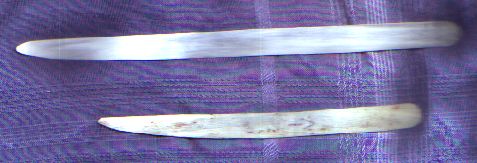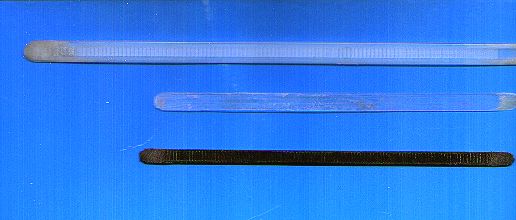photo: courtesy of Andrew Kasparian
Oud must be played with a plectrum, a flexible flat stick made with a variety of materials and measuring about 100-180 mm long and 8-10 mm width. The tips can be rounded (as in the photo above) or sharpened, it depends mainly upon the player's preference.
|
|
Two tip shapes: rounded and sharpened. |
About the building materials, we have quill and horn (the two conventional ones) and some new options:
1) quill: the classical material, originally obtained from eagles. Now that these birds are widely protected by laws, other suitable animals are ostrichs, vultures or gooses. I tried using goose quills, naturally shed from domestic gooses, with acceptable results. Any big quill can be useful. Once processed, it looks and feels like fingernails, since both are made from the same material: keratin.
|
A small size quill plectrum. |
2) horn: a very nice material for plectra, but difficult to make. They are my preferred ones, but it is a personal choice. Big horns must be used (not from cows).
 |
Two examples of horn plectra, both with rounded tips (at right). The sharpened opposite tips are not for playing purposes. |
3) sea tortoise shell: a Chinese oud player uses them to play his Turkish oud (see p & s gallery). He obtains the material from some old bracelets he has (tortoises are law protected nowadays). He sent me a couple, to test them. It is a non-conventional material, but helpful: very resistant and natural. I like it. Japaneses used shell plectra to play shamisen, a stringed instrument, but in this case plectra are big and triangular-shaped ones.
|
|
4) plastic: an easy to handle material, resistant but maybe not the "best" for playing purposes. Anyway, it is very common to use them. About the proper flexibility, there have been many attemps in order to discover the best suitable plastic.
 |
Three types of plastic plectra. They have different lenghts and flexibilities, depending upon the player's choice. |
The good notice regarding plastic plectra: you can make one easily!!
How to make an easy plastic plectrum
People on the net uses many kinds of plastic to make plectra. I have received some plectra made with tie wraps (see the photo above). They are these plastic strips used to join together a group of cables, can be got in any hardware shops by a few cents.
You can test many longs and consistence kinds of tie wraps, to reach one which fits you. Cut the locker tip, and proceed to round both tips as showed in the photo, with a sandpaper. Probably you should diminish the thickness. Just take care to sandpaper well, to get a very smooth surface. And try it! Prices are so low, that you can try and try, until getting a good working plectrum.
I found tie wrap plectra to have an excellent elasticity, and you can play hard with them without expecting a brake as in the other kind of plectra. I must say, anyway, horn plectra produces less crisping noises, but it can be a technique problem, I am not sure.
Good luck!
* * * * *